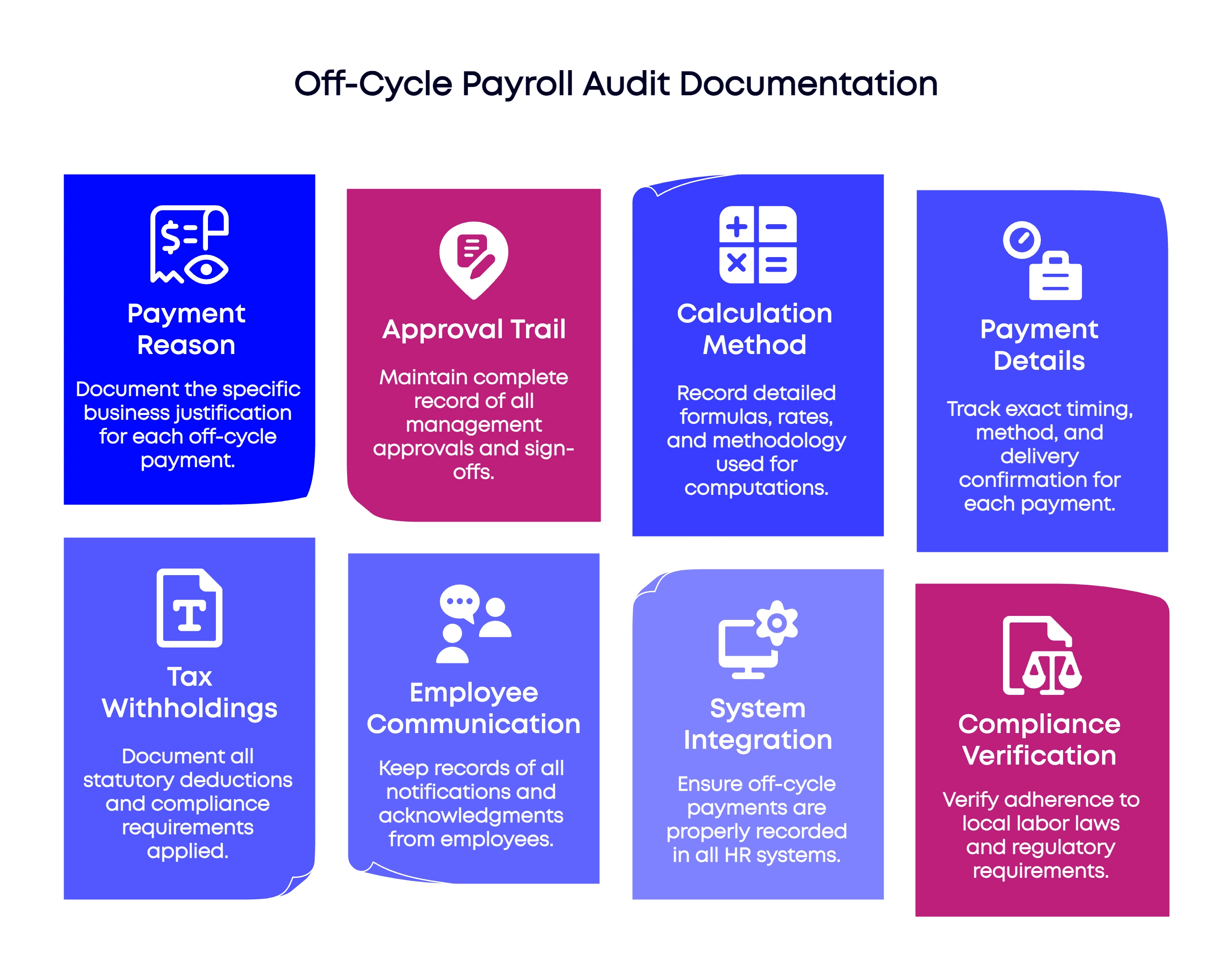Every month, employees around the world discover something’s not quite right with their paychecks - missing overtime, delayed bonuses, or unexpected deductions.
And these issues aren’t rare occurrences. They’re symptoms of a payroll system that, despite best efforts, is still vulnerable to human error and complexity.
In fact, payroll issues are more common than many employers realize.
More than 50% of workers globally have experienced a payroll error at some point in their careers.
Even more striking? 4 in 10 encountered one just within the past year.
The consequences are immediate and personal. Nearly 80% of employees say even a short delay in pay would make it difficult to cover essentials like rent, groceries, or bills. For many, there’s little room for error.
This is where off-cycle payroll becomes essential.
In this guide, we’ll break down what off-cycle payroll is, when it’s necessary, and how to manage it effectively - especially in today’s global, fast-moving workforce.
What Is Off-Cycle Payroll?
Off-cycle payroll refers to any payment made outside your company’s regular pay schedule.
While your standard payroll might follow a predictable cadence - say, biweekly or monthly - off-cycle runs happen on an as-needed basis. Whether it’s a Tuesday morning or late on a Friday afternoon, when the business calls for it, off-cycle payroll steps in.
At its core, the concept is straightforward: off-cycle payroll is any paycheck issued between regularly scheduled paydays. But in real-world operations, it's your response mechanism when normal schedules don't align with business needs.
In fact, across the Asia-Pacific region, 1 in 3 companies now rely on off-cycle wage increases as a way to stay competitive and responsive to market conditions.
Off-cycle runs aren’t just more frequent - they’re also more hands-on. Unlike your main payroll runs - often automated and scheduled in advance - each off-cycle payment typically involves:
- Manual calculations tailored to the situation
- Special tax handling, especially for bonuses or final payouts
- Additional layers of review and approval to ensure accuracy and compliance
When we work with companies building or scaling their global payroll systems, off-cycle capability is often non-negotiable - particularly when partnering with an Employer of Record who can provide the operational flexibility needed to process urgent payments while maintaining full compliance across multiple jurisdictions.
The businesses that embrace it - not just for emergencies, but as a strategic asset - tend to see smoother international expansion, stronger employee loyalty, and fewer disruptions when something unexpected comes up.
Off-Cycle Payroll vs On-Cycle Payroll
At their core, both off-cycle and on-cycle payroll have the same goal: paying employees correctly. However, the process and requirements behind the scenes can be quite different.
Here’s how they compare side by side:
When Your Business Actually Needs Off-Cycle Payroll
Off-cycle payroll isn’t just for correcting errors - it’s a strategic tool that companies can use intentionally. While often seen as a backup plan, there are moments when waiting for the next pay cycle simply isn’t an option.
Without the ability to act fast, companies risk not only compliance penalties, but also losing top talent and credibility.
Below are key scenarios where off-cycle payroll isn’t just helpful - it’s essential.
1. Final pay after an employee leaves
Employment laws in many countries require final paychecks to be delivered immediately or within a strict timeframe.
This is one of the key considerations when evaluating the pros and cons of outsourcing HR - having a partner who can execute these urgent payments while maintaining compliance becomes invaluable for global operations.
- California mandates payment on the employee’s last working day
- Estonia and Kazakhstan also require final wages to be settled on the day employment ends
Miss these deadlines, and penalties start adding up - daily. For businesses with larger teams, that can quickly translate into significant, avoidable costs.
Did you know? Nearly 1 in 3 employers cite employee terminations as their top reason for using off-cycle payroll.
2. New Hires Joining Mid-Pay Cycle
In today’s world, top talent doesn’t wait. If a new team member starts on the 10th and your next payroll isn’t until month-end, leaving them unpaid sends the wrong message.
Companies that issue off-cycle payments during a new hire’s first week gain a clear edge - demonstrating respect and responsiveness from day one.
3. Urgent salary or bonus adjustments
Retention isn’t always about long-term planning - sometimes, it’s about acting in the moment.
If a key employee receives a competing offer or if your team needs to respond to sudden market changes, waiting weeks to act can mean losing them.
Off-cycle payroll lets you deliver timely raises or bonuses, helping you retain high performers and reinforce loyalty when it matters most.
4. Commission payouts that match performance
For sales teams, timing is everything. A closed deal is cause for celebration - but delayed commissions can undermine that momentum.
Off-cycle payroll allows you to align recognition with results, making sure your team feels rewarded when the impact of their work is fresh.
5. Fixing payroll mistakes promptly
Even the best systems aren’t immune to error. Missed hours, incorrect deductions, or forgotten bonuses do happen.
What sets companies apart is how quickly they make things right.
Off-cycle corrections show employees their concerns are taken seriously - and that builds trust, which is difficult to rebuild once lost.
6. Supporting during personal emergencies
Life doesn’t always wait for payday. When employees face emergencies - whether medical, financial, or personal - being able to provide a wage advance or special payout can make a profound difference.
If you have the ability to process off-cycle payouts quickly, you’re not just supporting your team - you’re keeping people who might otherwise feel forced to leave.
Proven Methods for Managing Off-Cycle Payroll
Organizations that excel at off-cycle payroll don’t treat it as a one-off event - they treat it as a repeatable, well-governed process.
The most effective teams build systems that are controlled, compliant, and scalable - whether they’re handling a one-time bonus or final pay for a global workforce.
Here are six proven methods to get off-cycle payroll right:
- Set up clear approval workflows
Off-cycle payments should never be handled on the fly. Every request must pass through a defined process, typically involving:
- A formal written request from the initiating team
- Managerial approval to validate the need
- HR verification to ensure accuracy and compliance
This isn’t bureaucratic red tape - it’s a protective structure that helps prevent unauthorized payouts, calculation errors, and regulatory slip-ups.
- Use your core payroll platform - not manual workarounds
Modern payroll platforms are equipped to handle off-cycle payments, but only if they're used properly. Avoid patchwork fixes like spreadsheets or informal payments.
Instead, use your payroll system to:
- Process supplemental and one-time payments
- Maintain accurate tax and year-to-date calculations
- Ensure entries are automatically included in compliance reports
Companies that process off-cycle payrolls outside their core systems often face long-term reconciliation issues that can take months to untangle.
- Document every payment from start to finish
Off-cycle transactions are more likely to attract internal audits or external regulatory reviews.

Keeping a centralized log also allows teams to identify trends. For instance, frequent corrections tied to a specific team or process can signal deeper operational issues that need attention.
- Analyze off-cycle patterns to improve core payroll
Every off-cycle request is a data point. Over time, these can offer valuable insights into inefficiencies in your main payroll process.
Frequent corrections? Your time-tracking process might need refinement.
Many mid-cycle new hire payments? Look at adjusting onboarding or payroll cutoff timelines.
Repeated spot bonuses? It may be time to build those into a scheduled incentive cycle.
The goal isn’t to eliminate flexibility - but to reduce unnecessary exceptions by improving the system itself.
- Make it a cross-functional process
HR, Finance, and Payroll all touch off-cycle payments. But without coordination, what could be a simple adjustment often turns into a scramble.
To streamline the process:
- Hold weekly cross-team check-ins
- Maintain a shared calendar for visibility into terminations, promotions, and bonus events
- Encourage open channels for advance notice of payment needs
When these teams work in sync, off-cycle payroll becomes predictable and manageable, not disruptive.
- Maintain country-specific compliance checklists
When operating across borders, compliance requirements can vary dramatically. That’s why it’s essential to maintain localized payroll checklists by country.
Each checklist should include:
- Relevant tax rates and withholding rules
- Required employment documentation
- Legal payout deadlines, especially for terminations or bonuses
For example, final pay requirements in Germany will look very different from those in Brazil. Having this information readily available ensures quick and compliant execution across jurisdictions.
Off-Cycle Payroll Mistakes Every Business Should Know About
Even experienced payroll teams can stumble when it comes to off-cycle payments. Because these runs are often unplanned, high-pressure, and outside the normal rhythm of payroll operations.
Let’s walk through the 7 biggest pitfalls - and how to avoid them.
Mistake 1: No clear approval process
When a manager calls in a panic asking for an immediate check, it’s tempting to rush things through.
But skipping formal approvals can lead to:
- Unauthorized payments
- Tax missteps
- Even fraud risks
Solution: Put a clear, consistent approval workflow in place. Every off-cycle request should be:
- Submitted in writing
- Approved by HR and department heads
- Verified by Finance for high-value transactions
Verbal approvals are not enough - especially when money and compliance are on the line.
Mistake 2: Weak documentation and audit trail
Off-cycle payments are often the ones auditors and regulators scrutinize most. If you can’t show how, why, or who approved it, you’re vulnerable to audits, employee disputes, and regulatory penalties.
Fix it by documenting:
- Why the payment was made
- Who signed off
- How the amount was calculated
- When and how it was paid
Store these documents securely, ideally within employee files or a centralized payroll system. A clean audit trail protects both your employees and your business.
Mistake 3: Poor communication with employees
Off-cycle payments made without explanation can spark confusion, and worse - distrust. Unexpected deposits, delays, or discrepancies might be seen as signs of instability or favoritism.
Clear, proactive communication changes the narrative:
- Explain what the payment is for
- Share when it will arrive
- Apologize and clarify when correcting an error
Done well, this kind of transparency builds trust and shows that your organization takes payroll seriously.
Mistake 4: Processing outside the payroll system
Processing off-cycle payments outside your main payroll platform can create data mismatches and tax reporting errors. Spreadsheets and side processes may seem like a quick fix, but they often lead to inaccurate YTD figures, missed benefit deductions and reconciliation headaches.
Solution: Always use your core payroll system. If you must use an external method, update your main system immediately to keep records consistent and compliant.
Mistake 5: Overlooking local compliance rules
Payroll regulations vary widely - and applying the same approach everywhere is risky, which is why global hiring decisions like EOR vs contractor strategies require careful regional analysis.
For example:
- In California, final pay is due immediately upon termination.
- In the UK, it can wait until the next scheduled payday.
- Kazakhstan has unique currency rules for wage disbursement
Equip your team with country-specific compliance checklists and provide regular training, especially since your EOR vs staffing agency choice determines who bears legal responsibility for compliance violations.
When in doubt, always consult with experts.
Mistake 6: Not tracking off-cycle trends
Many companies treat off-cycle payments as isolated events. But when you zoom out, patterns often emerge - and they can reveal deeper operational issues.
Set up a system to:
- Categorize off-cycle payments (e.g. new hires, errors, bonuses)
- Monitor frequency across teams or departments
- Review trends monthly
If you notice recurring problems, it's time to adjust your processes, not just put out fires.
Mistake 7: No backup plan for payroll emergencies
What happens if your system goes down the day a final paycheck is due? Or your payroll lead is out sick?
Without a business continuity plan, emergencies can trigger delays, errors, and employee frustration.
.webp)
Preparedness ensures that even under pressure, payroll gets done right.
Mistakes happen - but they don’t have to be repeated. By addressing these common pitfalls head-on, companies can build a more resilient, transparent, and compliant off-cycle payroll process that protects both the business and the people behind it.
Summing Up
For many companies, their first real test of off-cycle payroll comes during international expansion - often under pressure, and at precisely the wrong moment.
It’s the moment your lead developer in Estonia resigns, and you have just 24 hours to calculate final wages, including unused holiday pay. Or when a terminated employee in Kazakhstan needs to be paid immediately in KZT - and the local labor authority is already watching.
After three decades supporting global expansion, one thing has become clear: the most successful organizations recognize that off-cycle payroll is a strategic asset. One that enables faster market entry, better compliance outcomes, and stronger talent retention.
That’s why our approach is built around integration.
By consolidating regular and off-cycle payroll into a single system across Europe, Asia, and emerging markets, we enable companies to move decisively. Whether it’s issuing same-day termination pay in Kazakhstan, meeting Estonia’s final-day requirements, or processing India’s TDS deductions accurately and on time - we ensure it all runs seamlessly.
Your payroll operations either enable growth or limit it. The choice is whether you'll invest in capability before you need it, or scramble to build it while opportunities slip away.
.webp)














